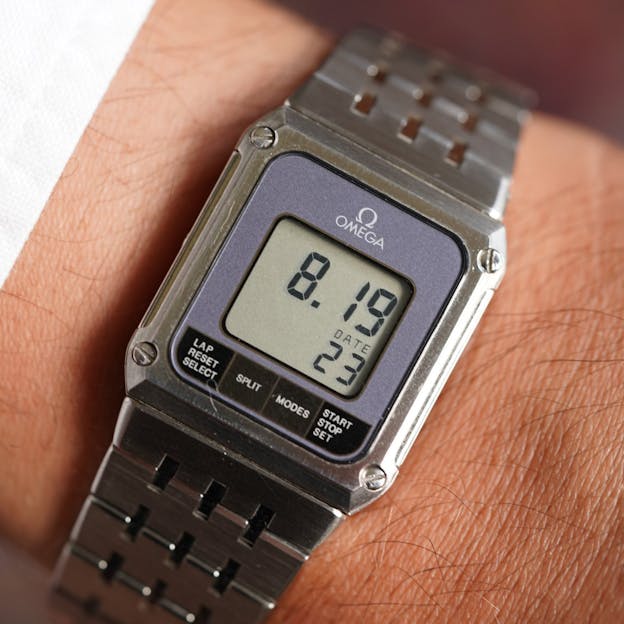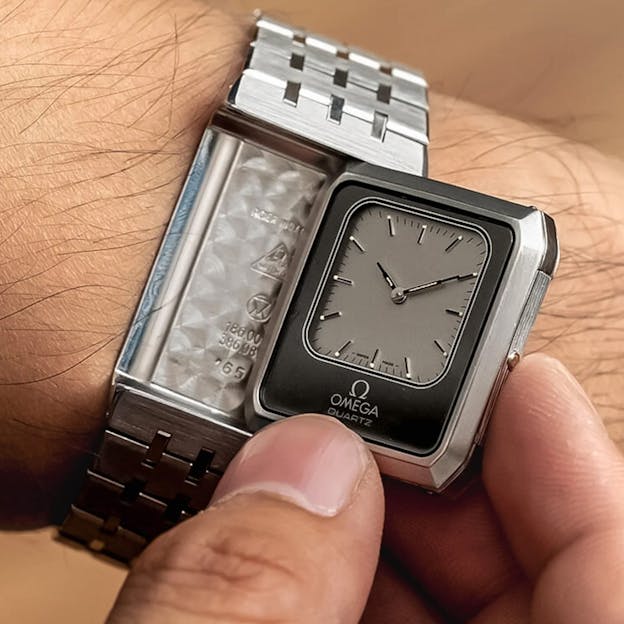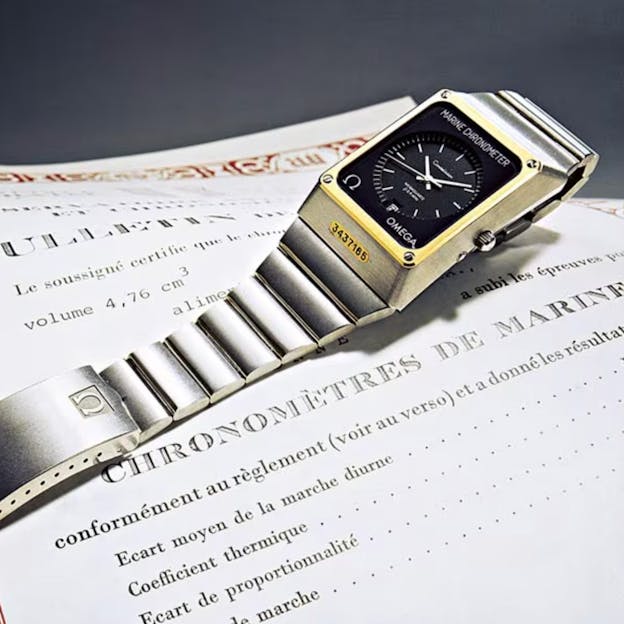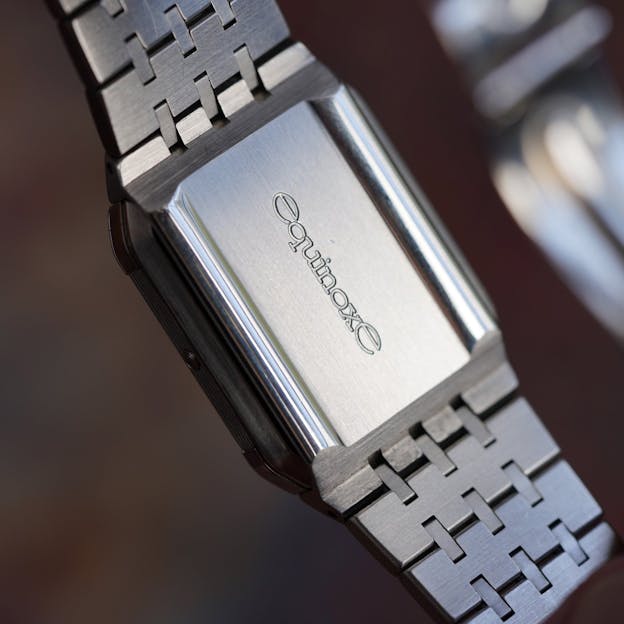Time Reconsidered: The Equinoxe Is Omega’s Forgotten Fever Dream
A high-horology Transformer from Omega’s weirdest era that has no business being this cool.
Lately, I’ve been covering what I’d call quirky, weird watches, those overlooked watches, with offbeat designs from decades past. And in my generally auspicious and somewhat whiny way, I use them as examples to talk poetically about how watch design needs to find its soul again. I’ve played with the title “Time Reconsidered.” We’ll see if it sticks though.
Anyway, this is a story about a watch that I have wanted to write about for far too long. The problem has been, other than loving this watch, there was no true angle. There was nothing I could discover in any of my conversations or research that was new or novel.
There’s no greater thesis. No investigative arc. I’m writing about this watch because I think it’s really freaking cool, and because all the previous coverage I’ve seen has somehow missed the mark. No one’s said it with the proper enthusiasm I suppose. Because in my opinion, which I like to hold in somewhat high regard, if you love watches, you will absolutely love this watch.

The Omega Equinoxe is an amalgamation (a word I’ve probably overused lately) of watch design. It’s a mash-up, a Frankenstein that isn’t fake, a high-horology Transformer. At first glance, it feels like the fever dream of a 12-year-old boy, just (mercifully), without the gratuitous lume. It’s almost a Reverso, because it flips. It’s got a Royal Oak adjacent integrated bracelet. It’s quartz. And there is absolutely nothing like it. Not before or since.
Sure, there are other rectangular quartz watches, but most of them belong next to the 35-cent “ride me” firetruck outside your local Hannaford’s. This one? This one’s different. It’s luxury, it’s also digital and analog, like some proto-Zeitwerk (though it predates the Zeitwerk by decades). The four exposed (functional) screws on the bezel give off a faint FP Journe Élégante vibe. The case? Not quite rectangular, not quite round. Not quite Ellipse. It makes absolutely no sense, and yet, somehow, it makes all the sense in the world.

You’ve probably seen it before, maybe scrolled past it. But I’d bet you’ve never seen one in the wild. And if you have, call me. Or better yet, email me. I screen my calls.
This all said, I think you can understand why I needed to write. Call it hubris, vanity, or just the inner workings of a true watch addict. When a watch gets stuck in my head, it rattles around like a pinball, trying to find its way out of my mouth and into your ears. Weird visual, I know.
But let’s get into it. Because the Omega Equinoxe is a piece of horological chaos, and it deserves our attention. Even if nothing I’m about to say is new, or groundbreaking, or revelatory in the slightest.
What We Know

This section is always a bit of a misleading one. “We” is a broad term. What I know, what I’ve been able to gather is limited to online resources and the collective brainpower floating around watch town. The Equinoxe, much like the Seamaster ‘Recife,’ was only around for about a year. Released in 1981 and discontinued the very same year, it hit the market at a then-gargantuan price of CHF 1,500. For perspective, that was enough to buy three mechanical Omega Seamasters at the time.
The early 1980s marked a pivotal moment in watchmaking. Quartz was no longer a passing trend, it was here to stay. In 1983 alone, Casio released the DW-5000C G-Shock and Swatch officially entered the scene. Yet, mechanical watchmaking wasn’t going quietly. In 1986, IWC launched the Da Vinci Perpetual Calendar, proving there was still a future for traditional craftsmanship and that mechanical watchmaking wasn’t going to fall off the face of the earth. It was a time of transition, and few watches capture the start of that shift better than the Equinoxe.

Omega, back then, was riding high on the quartz wave. Electronic timing was kind of their thing. In fact, they had already made the most accurate quartz watch of the era, the Marine Chronometer from 1974, which was precise to an absurd 0.002 seconds per day. And let’s not forget, Omega has long been the official timekeeper of the Olympics. So, despite our collective drooling over mechanical movements and the famed co-axial escapement, it’s actually precision quartz timekeeping that sits squarely in Omega’s wheelhouse, more than they’d probably care to admit.
The Equinoxe came in two variants: one in stainless steel and another in two-tone, with a gold-plated bezel. There were two displays: an LCD digital screen on one side, and an analog dial on the other. Flip the case, and voilà, it’s a different watch. The LCD side featured a countdown timer, alarm, chronograph, and the ever-so-rare hourly chime, which does exactly what you’d think it does.

There’s a theory floating around the underbelly of the internet that the watch was named “Equinoxe” (after the biannual event when day and night are equal in length) because the analog side was meant for daytime use, and the digital side for night. And when you look at the official ad slogan by Omega which states, “For all who love a change from time to time, the Equinoxe by Omega is as different as night and day.” That explanation feels so simple it has to be true.
Beyond the ad there isn’t much more info in Omega’s official archives. The design, the movement, the rationale behind it… there’s almost nothing documented. Maybe it is that simple. You can decide for yourself.
I’d love to say this watch was a first for something. But I can’t. There’s a claim out there that it was the first dual-dial wristwatch, but I can’t confirm or deny it. Teddy Baldassarre suggests that the rare Cartier ref. 3687 dual-time watch holds that distinction, but I am also unable to find the example in reference. After all, the first Jaeger-LeCoultre Reverso Duoface didn’t arrive until 1994, so the mystery, until Jack or Tim tell me otherwise, shall remain.
The Finer Details

The movement inside is the quartz caliber 1655. Go ahead, Google it. You’ll find more references to the famed Steve McQueen Explorer II than to this thing. From what I could dig up, it powers both the five-function LCD and the analog display, is accurate to within 5 seconds per month, and has a two-year battery life. That’s all I’ve got. If you know more, please, for the love of horological curiosity tell me. Don’t worry, I’ll wait.
As for the dimensions, the case measures 27mm across, 9mm thick, and 38mm lug-to-lug. It’s slightly wider but slightly shorter than the original Reverso (if comparisons are your thing). It looks like it was plucked straight from a Casio back catalog, but make no mistake, it’s Omega. (And for the record, I love my gold Casio.)
Then there is the bracelet. God it is so good and so unoriginal it hurts. It’s over engineered, uncomfortably intricate, and also clearly one of the major reasons this watch was so damn pricey (at the time) and so short lived. But you got to give credit where it’s due, the craftsmanship is undeniable. Each link is brushed with care, beveled on all sides, and accented with three polished rectangular inserts that give it a satisfyingly retro clink as it moves (reportedly). Tucked inside the clasp, there is “Mod Deposé” meaning this design was registered/trademarked for Omega. (As I slowly chant “bring it back, bring it back”).
My Take

I’ll keep this part short. You already know my take: Bring it back, Omega! By all that is holy, like my desire to teleport back to 2015 when the world still made a bit of sense, this watch deserves a resurrection. Its return would be like some glorious mashup of Tamagotchis, Furbies, actual Saturday morning cartoons, Rock ‘Em Sock ‘Em Robots, and Pogs. All of it, rolled into my never ending golden-age nostalgia of a time when things had soul and just the right amount of absurdity.
That’s it. I don’t know how many were made. The current asking price of an Equinoxe, based off some recent eBay listings can range from $1,500 to mid $3,000. There are no recent auction results I am aware of, and the few people I know who’ve sold one haven’t gotten back to me. But I couldn’t wait. Despite having no angle, no broader point, no commercial hook, this is a watch I had to share with you, dear reader, in my own way. Because it’s just that beautiful. It is just that weird. That wonderfully unnecessary object that reminds us why we collect in the first place.
The day I spot one of these in the wild, I’ll be sure to let you know. Because now that I’m a father, it might just be the last thing I need to cross off my bucket list.
I think I have a problem.
Feature Photo by the Eric Wind of Wind Vintage.

